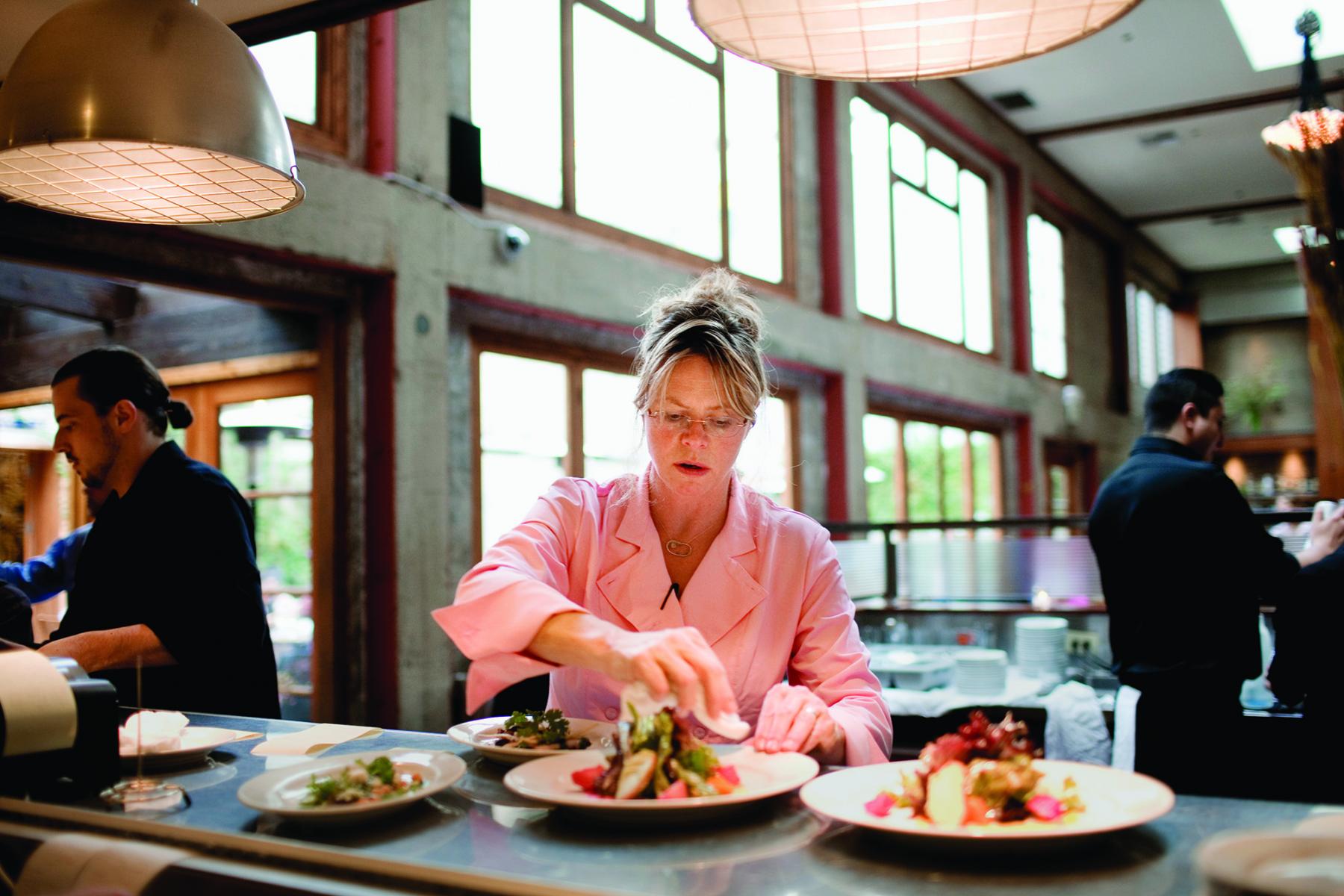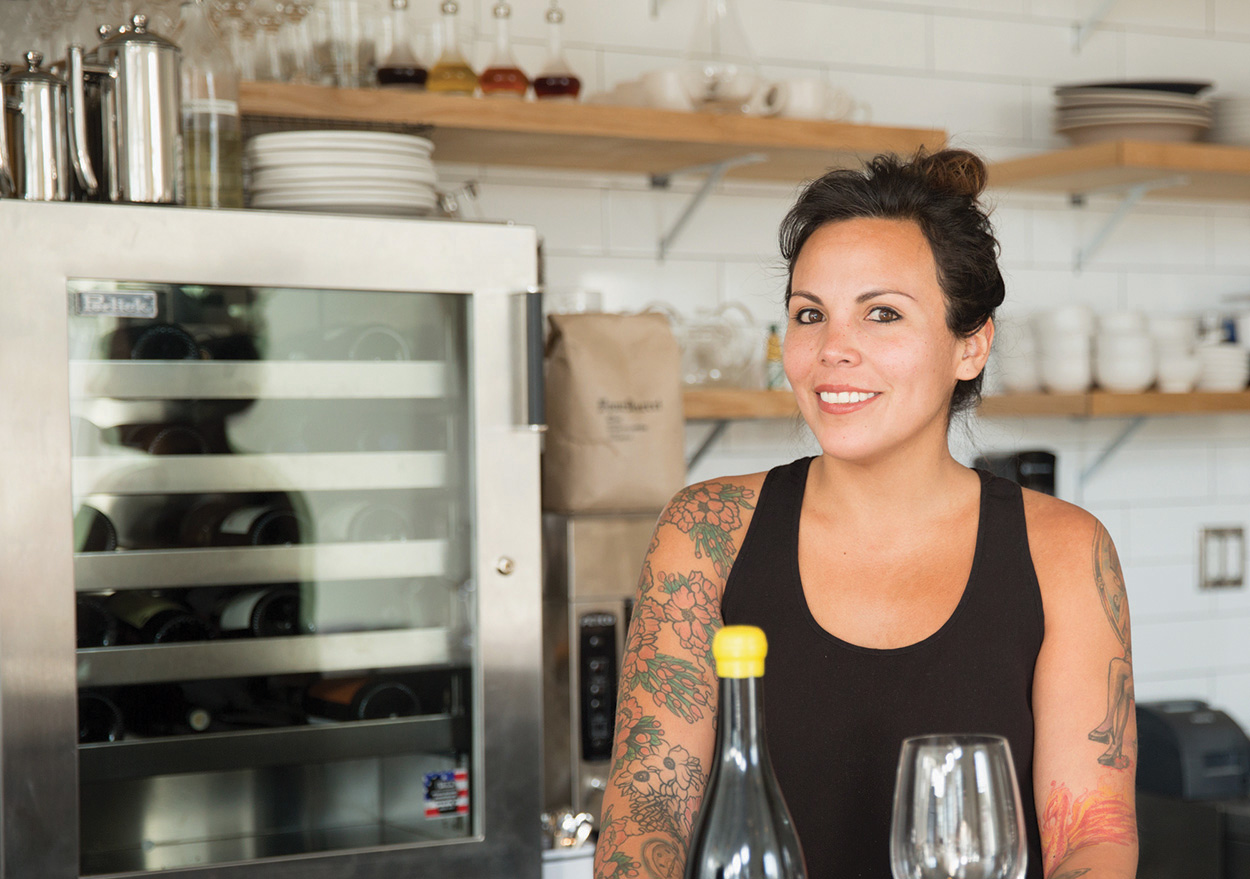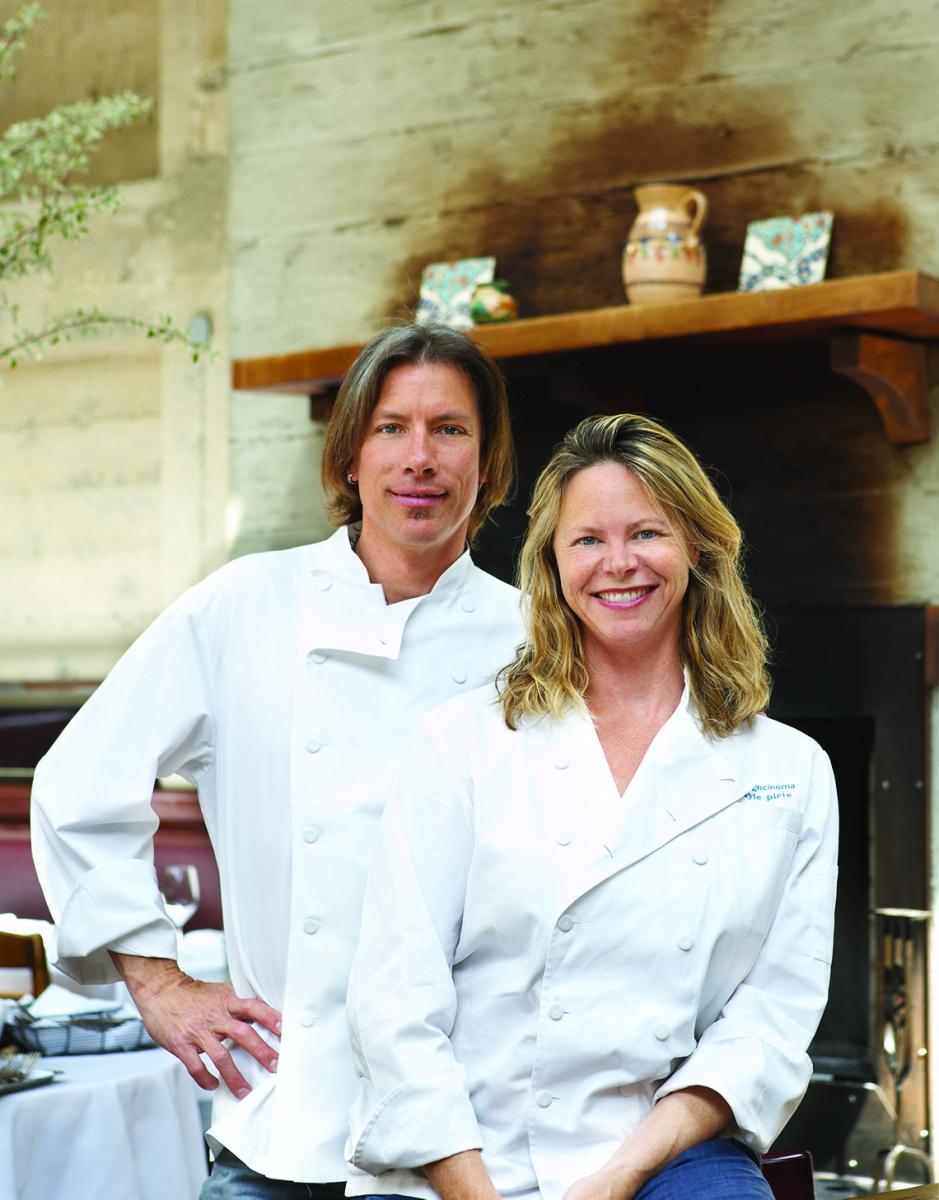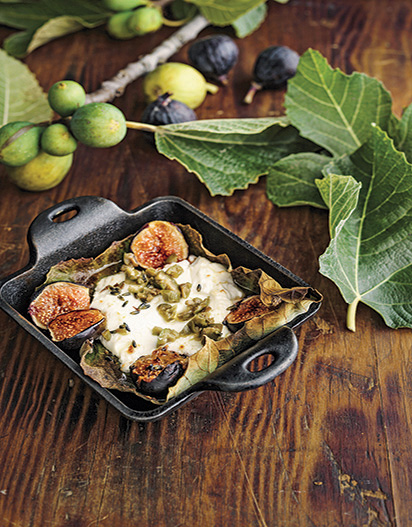Food-loving Gators turn sizzling kitchen skills into restaurant success

By Gina McIntyre
Restaurants are in Gayle Pirie’s blood. One half of the power couple behind Foreign Cinema — the chic Mission Street dining destination she oversees with husband John Clark — Pirie (B.A., ’91) was already working as a line cook at the city’s legendary Zuni Café when she began pursuing her degree at San Francisco State, originally studying painting before transitioning to art history. Eventually, she says, her “two crafts kinda fused together.”
It’s easy to spot the artistic flair she brings to every dish at Foreign Cinema, one of the San Francisco Chronicle’s Top 100 restaurants for 16 consecutive years.
“The compositional work that you do in your lifetime as an artist really translates to the finished plates that go out,” Pirie says. “You want to make sure there’s enough negative space, that the textures vary. Some painters are super precise and some live in the asymmetrical world. I live in the asymmetrical world.”
As two of the city’s most respected chefs, Pirie and Clark are part of an elite scene, many members of which share one thing in common: They all hold degrees from SF State. Some of the brightest stars in the culinary world have graduated from the University in the last two decades, going on to cook and consult across the country and around the globe. James Beard Award winners, Michelin-star recipients, Iron Chefs, authors, entrepreneurs behind some of the most successful eateries in the city — the Who’s Who roster of food and fine-dining alumni talent is staggering.
What’s at the heart of the connection? The city itself is attractive to anyone interested in good food thanks to its abundance of fresh seafood and produce and its proximity to the nation’s most storied wine regions. SF State offers flexible study arrangements and a variety of relevant course work to restaurant professionals, who routinely work long, demanding shifts at odd hours.
For Liz Subauste (B.A., ’10), that flexibility was key. As she was working toward her degree in Recreation, Parks, and Tourism — learning skills like event planning and how to motivate and manage large groups of people — Subauste was also a manager at the Mission District trattoria Delfina. “I would work a 10-hour shift and then go to school,” she says.
Eventually, Subauste took a job bartending at Ne Timeas Restaurant Group’s Italian hotspot Flour + Water and worked her way up through the ranks at the company before founding her own restaurant consulting business, Sobremesa. She says she’s struck by the close-knit nature of food professionals in the city.
“When you go to a farmer’s market on Saturdays in the morning, you can see all the chefs buy their stuff — they know the farmers,” she says. “Everybody really helps each other here. It’s not competitive in a bad way. I’ve worked Valentine’s Day, and we have run out of caviar, and the chef will be like, ‘Call so-and-so. See if we can borrow some.’ I don’t think other cities with this industry would be that open or that helpful.”

Gayle Pirie hard at work at Foreign Cinema.
While Subauste was in the nascent stages of her career during her student days, Ne Timeas co-founder David Steele (M.A., ’05) had already built a successful wealth management firm when he enrolled at SF State to pursue a degree in literature. He took classes part-time as he continued to run his businesses. “Education is important to me,” Steele says. “I wanted to challenge myself to use a different part of my brain than I had been using.”
Four years after earning his master’s, Steele and restauranteur Thomas McNaughton opened Flour + Water, which became the flagship for Ne Timeas. The group now operates three additional eateries — Central Kitchen, Salumeria and craft cocktail bar Trick Dog — and Steele says the company’s growth owes greatly to the passion for food so woven into the fabric of the city.
“Restaurant profits are, in the best case, abysmal and in the worst case, [restaurants] go out of business,” Steele says. “In order to achieve the best-case scenario, you have to have people appreciate spending money on something that took a lot of time and care in creating. There’s an appreciation for food and wine [here] that seems to go outside of only the affluent. In other cities, it seems much more associated with the affluent.”
Steve Sancimino (B.A., ’73) clearly remembers his days as an undergraduate seeking a history degree at SF State — back then, if you wanted to grab a bite between classes, your best bet was to head off campus. “There wasn’t a real cafeteria,” Sancimino recalls. “We used to go over to Herb’s on Taraval Street, especially on Thursdays. They had meatball sandwiches. We would go to a lot of places in the neighborhoods, over to Ocean Avenue, in the Lakeside Village … The school didn’t offer much in the way of eating.”
“There aren't too many hospitality programs that do what we do.”
— Joe LaVilla, SF State Restaurant Management Instructor
Sancimino, who co-owns Nob Hill’s landmark seafood eatery Swan Oyster Depot with four of his brothers, says that these days he’s struck by just how many dining choices are offered on campus. “I look at it and think, ‘My god, it’s a completely different world. [The campus food scene] has come a long way,’” he says.
Joe LaVilla has played an instrumental role in that change. An adjunct professor in SF State’s Hospitality and Tourism Management program, LaVilla runs the Vista Room, the on-campus restaurant that underwent a major renovation in 2015 to become a destination not just for faculty, students and staff but for the community at large thanks to innovations put in place by chef instructor Tim Shaw.
For the Vista Room, which serves lunch five days a week while classes are in session, Shaw and LaVilla collaborated on a seasonal menu that emphasizes sustainability. Located on the fourth floor of Burk Hall, the fine-dining restaurant functions as a “service laboratory.” Students gain hands-on experience in sanitation, service and guest behavior while working in the kitchen preparing and cooking dishes alongside Shaw and greeting and attending to diners in the “front of house” with LaVilla. It’s the sort of comprehensive approach typically reserved for culinary students.
“There aren’t too many hospitality programs that do what we do,” LaVilla explains. “[Students] come in here, and they have no idea how to cook, yet they end up putting out the food.”
They also can’t be sure who they’ll be serving that food to: members of the campus community who know that the Vista Room is student-operated or visitors who’ll simply be expecting a high-quality meal.
“They have to be on their toes, and they can’t be comfortable,” LaVilla says. “That’s a good thing.”
The University isn’t just producing great chefs. It can claim an “iron” one, as well.
It was on the SF State campus that acclaimed Moroccan chef Mourad Lahlou (B.A., ’93; M.A., ’95) launched his career. Arriving in the city from Marrakesh in 1985, he began to long for the cuisine of his homeland, and he decided to replicate some of its best-loved recipes, initially just for friends. In 1996, he opened his first restaurant, but it was 2001’s Aziza, named for his mother, that established his reputation as an international talent.
Since then, he’s defeated Cat Cora on Food Network’s cooking competition show, Iron Chef America, been awarded a Michelin star and opened the eponymous restaurant Mourad. Through it all, Lahlou says, his SF State studies were central to his success.

Restaurant consultant Liz Subauste
“When you go to college you don’t just learn what’s in the books,” he told SF State Magazine in 2010. “You learn responsibility, how to interact with people, how to be your best, how to push yourself. Running a restaurant business is a lot more than learning to cook. My econ degree helped me enormously, but mostly my interactions with professors and fellow students have helped me with what I do today.”
Clark Wolf (B.A., ’76) echoes those sentiments. The rock star restaurant consultant entered SF State through the drama department but graduated with a degree in English. Soon after, he began running a cheese shop at the base of Nob Hill on California Street — although he admits that back then he knew little about cheeses. In 1980, he opened the San Francisco outpost of the Napa Valley institution the Oakville Grocery.
He went on to write books, open restaurants, host conferences and develop academic curricula — and all of these experiences, he says, were informed by his days at SF State. “You learned how to learn,” Wolf says. “You had a good foundation, but you really had to go out and do it on your own, which in California and in food in general is a pretty good thing.”
“There are a lot of great opportunities at State,” adds Foreign Cinema’s Clark (B.A., ’85). “There are a lot of great professors motivating people. It’s an important part of the community. A lot of great people have learned great lessons at that school and applied them to their businesses.”
Pirie says she and Clark are privileged to see the tenacity of the next generation of SF State graduates up close almost every day. They’re an integral part of the team working to insure Foreign Cinema maintains its reputation for excellence and innovation.
“Our young staff, everyone is either getting into SF State or finishing up their work at State or they’re right in the middle of their work at State,” Pirie says. “It’s a great melting pot of energy.”

John Clark and Gayle Pirie recently released The Foreign Cinema Cookbook.

The cookbook includes the recipe for lavender baked goat cheese in fig leaves and other delicious dishes.